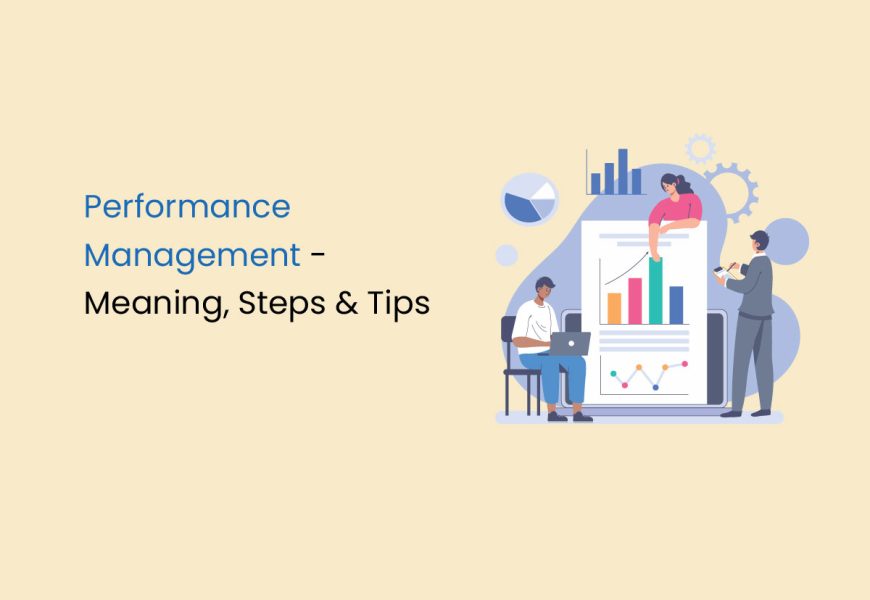In the past, performance management relied heavily on looking back and analysing past performance. However, with the evolution of organisational culture and technology, there’s a shift towards continuous feedback. Now, managers can anticipate issues based on real-time employee performance data and take proactive steps to address any concerns promptly.
In this article, we provide comprehensive insights into the concept of performance management, including its definition, the stages of the performance management cycle, recommended best practices, key features of effective performance management software, and a glimpse into the future of performance management.
What is Performance Management?
Performance management has evolved from a traditional, annual process to a continuous feedback system aimed at ensuring employees meet organisational objectives consistently. The shift reflects a move away from sporadic, subjective evaluations to ongoing, transparent communication between managers and employees.
According to Kathi Enderes and Matthew Shannon from Bersin, Deloitte Consulting LLP, many employees view traditional performance management as confusing and infrequent. However, automation has revolutionised the process, allowing for streamlined management of employee performance. This shift to continuous performance management marks a significant change in how organisations approach performance evaluation.
It’s essential to distinguish performance management from talent management. While talent management focuses on engaging and retaining employees, performance management guides employees in setting and achieving goals aligned with organisational objectives.
How Does Performance Management Work?
Performance management is a structured approach that facilitates alignment between managers and employees regarding expectations, goals, and career progression within an organisation. It plays a crucial role in directing resources allocated in the company’s performance budget and aims to achieve the highest standard of performance, even though it may be considered unattainable.
Traditional performance-management programs utilise tools like goal-setting, measurement of objectives, and milestone tracking to define and assess individual performance. However, unlike the conventional year-end review model, performance management fosters continuous learning and improvement by integrating feedback into everyday interactions between managers and employees.
Managers leverage performance management tools to optimise workflow, suggest strategic adjustments, and support employees in achieving their goals, thereby driving organisational success. For instance, a sales department manager may set revenue targets for team members and provide tailored guidance to enhance their performance.
Emphasizing ongoing accountability fosters a transparent work environment and improves communication through regular meetings. Clear expectations reduce workplace stress, as employees understand what is required of them, and managers can address performance issues proactively. According to a Gallup survey, a significant percentage of workers strongly agreed that their managers involve them in goal setting, highlighting the effectiveness of performance management in enhancing employee engagement and productivity.
Steps in Performance Management
Performance management involves several key steps that are essential for its effective implementation. While off-the-shelf software solutions exist, organisations often customise templates to suit their unique requirements. Here are the common steps involved in performance management:
Planning
At this stage, employees’ goals are set and communicated clearly. While these goals should be outlined in the job description during recruitment, they should be reiterated upon the employee’s onboarding. Depending on the organisation’s performance management process, assigning a percentage to each goal can aid in evaluating their achievement.
Monitoring
Managers are tasked with monitoring employees’ performance against their goals in this phase. Continuous performance management becomes vital here, facilitated by suitable performance management software. Real-time tracking allows for timely course corrections and modifications as needed.
Developing
Utilising data obtained during the monitoring phase, efforts are made to enhance employees’ performance. This may involve recommending training courses, providing assignments to improve skills, or adjusting development plans to sustain or enhance performance levels.
Rating
Periodic rating of each employee’s performance is crucial, particularly during performance appraisals. Ratings serve to assess the state of employee performance and guide necessary adjustments. Feedback from both peers and managers, such as 360-degree feedback, can contribute to the rating process.
Rewarding
Recognising and rewarding outstanding performance is integral to the performance management process and employee engagement. Appreciation can take various forms, ranging from a simple thank you to social recognition or participation in a comprehensive employee rewards program designed to acknowledge and incentivise excellent performance across the organisation.
Why is Performance Management Important?
Performance management is crucial for several reasons:
- Enhances Communication: Continuous performance management fosters ongoing communication between managers and employees. It prepares them for annual performance reviews by keeping them informed about changes to the process and areas for improvement, facilitating a smoother evaluation process.
- Demonstrates Value: Regular feedback and check-ins demonstrate to employees that their managers value their contributions and are invested in their growth and development. This fosters a sense of trust and engagement, as employees feel supported in achieving their goals and addressing any challenges they encounter.
- Encourages Openness: Employees are more likely to be receptive to feedback and coaching in a continuous performance management environment. They feel comfortable discussing their work, goals, and concerns with their managers, leading to increased transparency and collaboration.
- Facilitates Improvement: Continuous performance management enables timely identification of areas for improvement and opportunities for development. Managers can provide constructive feedback and guidance to help employees address performance gaps and enhance their skills, leading to overall improvement in performance.
How To Make Your Performance Management Process Better?
To enhance the performance management process, consider the following steps:
- Understand Employee Needs: Start by evaluating what your workforce desires from the performance management system. Engage in conversations with employees and managers to identify pain points and areas for improvement. Share these insights with decision-makers to drive change effectively.
- Implement Continuous Performance Management: Shift towards a continuous performance management approach that emphasises ongoing feedback and conversations between employees and managers. Focus on motivating employees by ensuring that discussions revolve around goals, progress, and personal growth opportunities.
- Promote Future-Focused Conversations: Encourage managers to engage in future-oriented discussions with employees, focusing on their career aspirations, goal achievement, and alignment with organisational priorities. Provide training to managers on delivering productive feedback and asking the right questions to support employee development.
- Equip Managers: Provide managers with the necessary tools and training to effectively manage the performance management process. Ensure they are proficient in giving and receiving feedback and are capable of facilitating frequent, lightweight conversations with their teams.
- Utilise Technology: Invest in HR technology that supports continuous performance management. Choose platforms that facilitate ongoing feedback, goal setting, and progress tracking. Ensure that the technology is user-friendly and aligns with the organisation’s performance management objectives.
Management by Objectives vs. Performance Management
Management by Objectives (MBO) and performance management share similarities, but they also have distinct differences in their approaches and objectives.
MBO is a corporate leadership model that aims to align employees’ goals with organizational objectives. It typically involves five key steps: defining objectives, communicating them to employees, monitoring progress, evaluating performance, and rewarding achievements. While MBO encourages employee participation in goal-setting, it has been criticised for its rigidity and sole focus on goals, potentially leading to undesirable outcomes.
On the other hand, performance management encompasses a broader range of activities beyond goal-setting, including ongoing feedback, coaching, and development. Unlike MBO, performance management emphasises continuous communication between managers and employees, fostering a dynamic relationship focused on achieving both individual and organisational goals. Additionally, performance management is adaptable and can evolve over time to meet changing business needs and employee expectations.
While MBO may have fallen out of fashion in recent years, performance management remains a vital component of organizational success, promoting employee engagement, development, and alignment with strategic objectives.
Characteristics of Effective Performance Management
Effective employee performance management goes beyond simply having the components of the performance management cycle in place. While those elements are essential, true effectiveness requires several additional factors:
- Leadership Buy-In: Leadership and senior management must fully support and endorse the performance management process. Their commitment sets the tone for the entire organisation and reinforces the importance of performance management in achieving strategic objectives.
- Continuous Process: Performance management should be an ongoing and continuous process rather than a once-a-year event. Regular check-ins, feedback sessions, and performance discussions ensure that employees receive timely guidance and support to improve their performance throughout the year.
- Meaningful Conversations: Performance conversations and reviews should be meaningful and substantive, focusing on employee development and growth rather than simply checking boxes. Managers should engage in open and honest dialogue with employees, addressing strengths, areas for improvement, and career aspirations.
- User-Friendly Software: Implementing user-friendly performance management software can streamline the process and provide visibility into performance management activities. The software should support various aspects of performance management, including goal setting, feedback, and performance reviews, making it easier for both managers and employees to engage in the process.
- Managerial Skills and Willingness: The effectiveness of performance management ultimately depends on the skills and willingness of managers to deliver it effectively. Managers should possess the necessary communication, coaching, and leadership skills to conduct performance discussions, provide constructive feedback, and support employee development on a day-to-day basis.
Ineffective Performance Management
Several factors can contribute to the ineffectiveness and uninspiring nature of performance management systems:
- Lack of Fairness and Accuracy: Annual reviews, favoured over continuous performance management, can lead to unfair and inaccurate assessments. Summarising an employee’s entire year of performance in one sitting can overlook crucial details and events. Managers may struggle to recall relevant information from a year ago, resulting in incomplete feedback and recognition. Annual reviews may lack credibility without a trusting relationship between employees and managers.
- Box-Ticking Mentality: Some managers treat employee performance management as a box-ticking exercise, going through the motions without genuine engagement. They may perform reviews and give feedback but fail to revisit and revise development objectives. This superficial approach undermines the effectiveness of the performance management process and demotivates employees.
- Obsolete Paper-and-Pen Systems: Reliance on outdated systems can hinder efficiency and effectiveness. In today’s digital age, businesses need to invest in user-friendly and streamlined technology to facilitate performance management processes efficiently.
- Emphasis on Appraisal Over Coaching: Performance management systems focused solely on appraisal can create a culture of judgment and anxiety among employees. Instead of feeling supported and encouraged, employees may dread performance discussions. Managers should adopt a coaching approach, providing constructive feedback and guidance to help employees grow and develop.
Tips to Make Your Performance Management More Effective
Effective performance management requires a strategic approach and adherence to certain best practices. Here’s how organisations can ensure success in managing employee performance:
Well-Designed Performance Management Strategy
A comprehensive performance management strategy is essential for guiding the process effectively. This includes determining the frequency of performance evaluations, establishing evaluation systems, defining feedback approaches, and implementing post-feedback evaluation mechanisms. Additionally, embracing bite-sized feedback provided by those closest to the work facilitates continuous improvement and learning. Leveraging automated performance management tools simplifies goal setting, modification, communication, and progress tracking without the need for unnecessary meetings.
Culture of Open and Effective Communication
Promoting transparent communication across all levels of the organisation is vital. Top leadership should set the tone by fostering an environment where honest feedback is encouraged, and support is provided to help employees improve. Hiring managers skilled in delivering constructive feedback and motivating employees while holding them accountable is crucial. Clearly communicating expectations, coaching employees to reach their potential, providing actionable feedback, and outlining rewards for goal achievement contribute to a positive communication culture.
Continuous Monitoring
Implementing continuous monitoring allows organisations to track employee progress in real-time and monitor output and outcomes effectively. Observation, interactions, and sentiment analysis tools help assess teams’ overall mood and promptly address specific issues. Leveraging automated performance management software enables granular monitoring of employee performance, objective data collection, and facilitation of meaningful conversations with employees.
Future Practises Of Performance Management
The future of performance management is undergoing significant changes, driven by evolving organisational practices and technological advancements. Here are some key trends shaping the future of performance management:
Shift away from Annual Performance Management
Traditional annual performance reviews are becoming less common as organisations embrace more agile and continuous approaches to performance management. Fluid performance management, characterised by regular feedback and goal adjustments, is gaining popularity as it allows for greater flexibility and responsiveness to changing circumstances.
Emphasis on One-on-One Feedback
While annual reviews may be fading, the importance of one-on-one feedback is increasing. Regular feedback sessions between managers and employees are essential for ensuring alignment with organisational objectives and facilitating continuous improvement. Managers are crucial in coaching employees and adjusting workflows to support goal achievement.
Integration of Performance Management Technology
Advancements in technology, including smart machines, artificial intelligence, and cognitive computing, are reshaping performance management practices. These technologies enable more personalised and seamless performance management experiences. Systems that integrate performance activities into everyday work processes are becoming more prevalent, streamlining performance management and enhancing user experience.
Overall, the future of performance management lies in aligning effective systems with skilled managers who can deliver regular feedback and support to employees. By embracing continuous feedback, leveraging technology, and prioritising employee development, organisations can create a motivated workforce and drive improved business outcomes.
FAQs about Performance Management
What are SMART goals and how are they used?
SMART goals are specific, measurable, achievable, relevant, and time-bound objectives utilised in goal-setting. This approach encourages setting clear, quantifiable, realistic goals aligned with objectives and accompanied by a defined timeline for achievement.
What are the 3 types of performance management?
There are three primary types of organisational performance management:
- The Balanced Scorecard: Emphasizes strategic objectives and performance metrics across different perspectives.
- Management by Objectives (MBO): Involves setting specific, measurable objectives aligned with organisational goals.
- Budget-driven Business Plans: Links performance goals with budgetary allocations to support strategic objectives effectively.
What are the 5 elements of performance management?
Performance management comprises five essential components:
- Planning: Setting clear performance expectations and goals.
- Monitoring: Regularly tracking and assessing progress toward goals.
- Developing: Providing support and resources to help employees improve performance.
- Rating: Evaluating employee performance against predefined criteria or standards.
- Rewarding: Recognizing and rewarding employees for their achievements and contributions.
What are the 4 purposes of performance management?
The performance management system serves four main purposes:
- Setting Expectations: Collaboratively defining performance expectations and goals for employees.
- Identifying Employee Goals: Aligning individual goals with organisational objectives.
- Performance Measurement: Establishing metrics and criteria to assess employee performance objectively.
- Providing Feedback: Facilitating ongoing communication between managers and employees to share performance reviews, provide feedback, and support development efforts.














